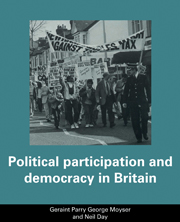Book contents
- Frontmatter
- Contents
- List of figures
- List of charts and maps
- List of tables
- Preface
- Part I Theories and methods
- Part II Patterns and pathways
- Part III Issues and actions
- Part IV The local process
- Part V Conclusions
- Appendix A Survey methods
- Appendix B Measuring elite-citizen concurrence
- Appendix C The National Questionnaire
- Endnotes
- Bibliography
- Index
Appendix B - Measuring elite-citizen concurrence
Published online by Cambridge University Press: 03 May 2011
- Frontmatter
- Contents
- List of figures
- List of charts and maps
- List of tables
- Preface
- Part I Theories and methods
- Part II Patterns and pathways
- Part III Issues and actions
- Part IV The local process
- Part V Conclusions
- Appendix A Survey methods
- Appendix B Measuring elite-citizen concurrence
- Appendix C The National Questionnaire
- Endnotes
- Bibliography
- Index
Summary
The concurrence scales used in chapter 17 are intended to measure the extent of issue agreement between mass and elite respondents in each locality.
All these scales are based upon questions about the ‘issues, needs or problems’ in the local area as perceived by the leaders and citizenry. In each locality, therefore, there are two ‘issue agendas’ representing the aggregation of, respectively, elite and citizen responses within a common framework of 13 categories of issues. Up to 4 issues were coded at the elite and the citizen levels for each respondent. Where there were two aspects to an issue, such as ‘youth unemployment’, these were counted as two issues – ‘youth’ and ‘unemployment’. This meant that a maximum of eight responses could be coded for each individual.
A score was derived that would measure the degree of similarity (and hence concurrence) between the two agendas in each locality. Each individual leader was assigned a similarity or concurrence score measuring the extent of the correspondence between that particular individual's personal issue agenda and the aggregate agenda of the citizenry in his or her locality. Equally, a score was given for each citizen, reflecting the amount of agreement between that individual's agenda and the aggregated leader agenda in the given locality. These two sets of concurrence scores are related because they derive from the same agendas in each locality. But they are not identical or symmetrical.
- Type
- Chapter
- Information
- Political Participation and Democracy in Britain , pp. 439 - 440Publisher: Cambridge University PressPrint publication year: 1992



